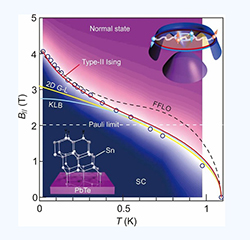Science reports President Qi-Kun Xue, Adjunct Scientist Ding Zhang and collaborators’ work: Type-II Ising pairing in few-layer stanene
2020/03/13
T he Sino-German collaborative research team, led by BAQIS President Qi-Kun Xue, BAQIS Adjunct Scientist Ding Zhang and Prof. Jurgen Smet of Max Planck Institute for Solid State Research, recently found that few-layer stanene can host unexpectedly high in-plane upper critical fields with abnormal temperature dependence. They proposed a new type of pairing mechanism that could account for this peculiar effect. This work has been published online in Science in March 2020, entitled “Type-II Ising pairing in few-layer stanine”. Other collaborators include Dr. Haiwen Liu (Beijing Normal University), Prof. Wenhui Duan (BAQIS Adjunct Scientist/Tsinghua University), Prof. Ke He (BAQIS Adjunct Scientist/Tsinghua University), etc.
he Sino-German collaborative research team, led by BAQIS President Qi-Kun Xue, BAQIS Adjunct Scientist Ding Zhang and Prof. Jurgen Smet of Max Planck Institute for Solid State Research, recently found that few-layer stanene can host unexpectedly high in-plane upper critical fields with abnormal temperature dependence. They proposed a new type of pairing mechanism that could account for this peculiar effect. This work has been published online in Science in March 2020, entitled “Type-II Ising pairing in few-layer stanine”. Other collaborators include Dr. Haiwen Liu (Beijing Normal University), Prof. Wenhui Duan (BAQIS Adjunct Scientist/Tsinghua University), Prof. Ke He (BAQIS Adjunct Scientist/Tsinghua University), etc.
The critical field of a superconductor refers to the magnetic field that is required to transit the superconducting state to normal state at a given temperature. The first superconductor Hg has a critical field of only a few tens of mili-Tesla. Recently, it has been reported that certain thin films with thickness of only several atomic layers can sustain in superconducting state under a magnetic field up to several tens of Tesla. In order to explain this phenomenon, the Ising pairing mechanism is proposed, which is believed to be due to the lattice with broken inversion symmetry so that the spin orientation of the electrons participating in superconducting pairing is locked. This scenario is supported by some 2D superconductors with broken inversion symmetry. An alternative explanation is that the extraordinarily high critical field can be a dimensionality effect. If the Ising pairing model really works, one should expect a low-temperature divergence behavior of critical magnetic fields, which, however, has not been experimentally verified yet.
In this work, for the first time, a critical field that is several times the theoretical expectation was detected in few-layer stanene with inversion symmetry. More importantly, the divergent behavior of the critical magnetic field when the temperature approaches absolute zero was clearly observed, providing strong evidence for Ising superconductivity. Through the close experimental and theoretical collaboration, a new type of Ising pairing mechanism is proposed combining both spin orbit coupling and crystal symmetry.
Link: http://science.sciencemag.org/content/early/2020/03/11/science.aax3873
- Joint Team from Beijing Academy of Quantum Information Sciences and Tsinghua University Achieves New Breakthrough in Simulating Chemical Molecules Using Quantum Computers
- Nature Physics reports Prof. Jian Wang and collaborators' work: Discovery of zero-energy bound states at both ends of a one-dimensional atomic line defect
 中文
中文 Email
Email QCloud
QCloud Log in
Log in
